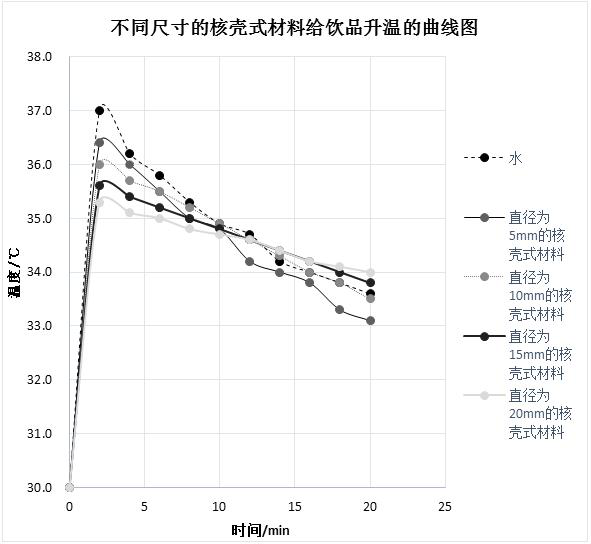A preparation method of core-shell material for beverage insulation
A technology of core-shell and beverages, which is applied in the field of preparation of core-shell materials for beverage insulation, and can solve problems such as dilution and affecting taste
- Summary
- Abstract
- Description
- Claims
- Application Information
AI Technical Summary
Problems solved by technology
Method used
Image
Examples
Embodiment 1
[0034] (1) Raw material preprocessing: crush, grind and dry quartz sand, soda ash, feldspar, limestone, dolomite, fluorite, barite and chrome slag respectively;
[0035] (2) Ingredients: Quartz sand: soda ash: limestone: feldspar: fluorite: dolomite: barite: chrome slag = 51.57: 15.82: 15.62: 6.25: 5.47: 1.76: 1.56 : The ratio of 1.95 is weighed and mixed in the mixer;
[0036] (3) Melting: place the mixed material in a pool kiln and heat it at a high temperature of 1200°C to form a uniform, bubble-free liquid glass that meets the molding requirements;
[0037] (4) Forming: The melted liquid glass is molded into a hollow glass sphere with a small hole in diameter of 5 mm. The inner wall thickness of the hollow glass product is 0.5 mm, and the hollow cavity accounts for 80% of the volume of the glass product. The hole diameter is 1mm;
[0038] (5) filling: aluminum sulfate is filled into the hollow cavity of the hollow glass sphere, and the filling amount accounts for 80% of ...
Embodiment 2
[0044] (1) Raw material preprocessing: crush, grind and dry quartz sand, soda ash, feldspar, limestone, dolomite, fluorite, barite and chrome slag respectively;
[0045] (2) Ingredients: Quartz sand: soda ash: limestone: feldspar: fluorite: dolomite: barite: chrome slag = 51.57: 15.82: 15.62: 6.25: 5.47: 1.76: 1.56 : The ratio of 1.95 is weighed and mixed in the mixer;
[0046] (3) Melting: place the mixed material in a crucible kiln and heat it at a high temperature of 1600°C to form a uniform, bubble-free liquid glass that meets the molding requirements;
[0047] (4) Forming: The molten glass is molded into a hollow glass sphere with a small hole in diameter of 10mm. The inner wall thickness of the hollow glass product is 1mm, and the hollow cavity accounts for 80% of the volume of the glass product. The hole diameter is 2mm;
[0048] (5) filling: aluminum sulfate is filled into the hollow cavity of the hollow glass sphere, and the filling amount accounts for 80% of the vo...
Embodiment 3
[0054] (1) Raw material preprocessing: crush, grind and dry quartz sand, soda ash, feldspar, limestone, dolomite, fluorite, barite and chrome slag respectively;
[0055] (2) Ingredients: Quartz sand: soda ash: limestone: feldspar: fluorite: dolomite: barite: chrome slag = 51.57: 15.82: 15.62: 6.25: 5.47: 1.76: 1.56 : The ratio of 1.95 is weighed and mixed in the mixer;
[0056] (3) Melting: Place the mixed materials in a pool kiln for heating at a high temperature of 1600°C to form a uniform, bubble-free liquid glass that meets the molding requirements;
[0057] (4) Forming: The melted liquid glass is molded into a hollow glass sphere with a small hole in diameter of 15 mm. The inner wall thickness of the hollow glass product is 1.5 mm, and the hollow cavity accounts for 80% of the volume of the glass product. The hole diameter is 3mm;
[0058] (5) filling: aluminum sulfate is filled into the hollow cavity of the hollow glass sphere, and the filling amount accounts for 80% o...
PUM
| Property | Measurement | Unit |
|---|---|---|
| thickness | aaaaa | aaaaa |
Abstract
Description
Claims
Application Information
 Login to View More
Login to View More - R&D
- Intellectual Property
- Life Sciences
- Materials
- Tech Scout
- Unparalleled Data Quality
- Higher Quality Content
- 60% Fewer Hallucinations
Browse by: Latest US Patents, China's latest patents, Technical Efficacy Thesaurus, Application Domain, Technology Topic, Popular Technical Reports.
© 2025 PatSnap. All rights reserved.Legal|Privacy policy|Modern Slavery Act Transparency Statement|Sitemap|About US| Contact US: help@patsnap.com

